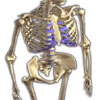Some overweight adolescents may be at risk for weak bones
Overweight adolescents already struggling with risk factors such as insulin resistance may need to add weak bones to their list of health concerns, researchers report.
A study of 143 overweight 14–18 year olds showed those with risk factors such as the precursor for diabetes and low levels of the blood-vessel protecting HDL cholesterol have less bone mass – an indicator of bone strength – than their overweight but otherwise healthy peers, according to researchers at Georgia Health Sciences University’s Georgia Prevention Institute.
Other risk factors included high fat levels in the blood, higher blood pressure and a larger waist size, said Dr Norman Pollock, GHSU bone biologist and corresponding author of the study published in the Journal of Pediatrics. In fact, total body fat didn’t seem to impact bone mass: it was fat around the middle, or visceral fat, that seemed to increase the risk for bad bones just like it does the risk of diabetes and heart disease.
“The more risk factors you have, the less bone mass you have,” Pollock said, noting that 62 per cent of the overweight adolescents had at least one risk factor. It also indicates that the concept of “fit and fat” may apply to the bones.
Study participants without one or more of these risk factors tended to get slightly more vigorous physical activity although none of the participants got the recommended 60-plus minutes of daily physical activity, Pollock said. Interestingly daily caloric intake for all study participants was in the optimal range.
“This says to kids and their parents that restricting calories is not the answer; we need to focus more on increasing vigorous physical activity,” Pollock said. Vigorous activity is defined as activity that increases the heart rate high enough to cause heavy breathing, such as jogging, tennis or jumping jacks. Studies have shown that physical activity prompts bones to release a hormone called osteocalcin, which helps decrease fat-related risk factors such as insulin resistance.
“We are now beginning to respect the bones as an endocrine organ like we do now with fat and muscle,” Pollock noted. Activity also increases the number of bone-producing cells called osteoblasts.
The study appears to be the first analysing bone-fat relationships and cardiometabolic risk factors in youth. Animal studies have shown, for example, that hypertensive mice have weaker bones.
Scientific literature on the impact of fat on bone health in children and adolescents has been confusing and even contradictory, writes Dr Heidi J. Kalkwarf, Division of General and Community Pediatrics at Cincinnati Children’s Hospital Medical Center in an accompanying editorial in the Journal of Pediatrics. Pollock’s research adds the “additional twist” that the presence of cardiometabolic risk factors indicates lower bone mass, she wrote.
The new study also raises more clinical questions, such as whether weight loss will help children improve bone mass and whether reduced mass during adolescence translates to increased fracture risk in adulthood, she wrote, noting that additional research is needed to assess long-term implications.
Peak bone mass is generally reached by early adulthood, so conditions that reduce optimal bone accumulation likely will lead to problems such as osteoporosis and fractures, the researchers report.
(Source: Georgia Health Sciences University: Journal of Pediatrics)
More information
 | For more information on obesity, health and social issues, and methods of weight loss, as well as some useful tools, see Obesity and Weight Loss. |
 | For more information on osteoporosis, including its effect on bones and the importance of nutrition and dairy, as well as some useful videos and tools, see Osteoporosis. |
Dates
Tags
Created by:

 Login
Login














